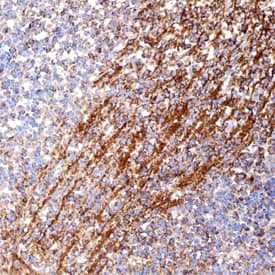Mouse Semaphorin 3F Antibody
R&D Systems, part of Bio-Techne | Catalog # MAB3237

Key Product Details
Species Reactivity
Validated:
Cited:
Applications
Validated:
Cited:
Label
Antibody Source
Product Specifications
Immunogen
Ala19 Pro775 (Arg583Ala and Arg586Ala)
Accession # O88632
Specificity
Clonality
Host
Isotype
Scientific Data Images for Mouse Semaphorin 3F Antibody
Semaphorin 3F in Mouse Brain.
Semaphorin 3F was detected in immersion fixed frozen sections of embryonic mouse brain (13 d.p.c.) using Rat Anti-Mouse Semaphorin 3F Monoclonal Antibody (Catalog # MAB3237) at 25 µg/mL overnight at 4 °C. Tissue was stained using the Anti-Rat HRP-DAB Cell & Tissue Staining Kit (brown; Catalog # CTS017) and counterstained with hematoxylin (blue). Specific staining was localized to neuronal processes. View our protocol for Chromogenic IHC Staining of Frozen Tissue Sections.Applications for Mouse Semaphorin 3F Antibody
Immunohistochemistry
Sample: Immersion fixed frozen sections of embryonic mouse brain (13 d.p.c.)
Formulation, Preparation, and Storage
Purification
Reconstitution
Formulation
Shipping
Stability & Storage
- 12 months from date of receipt, -20 to -70 °C as supplied.
- 1 month, 2 to 8 °C under sterile conditions after reconstitution.
- 6 months, -20 to -70 °C under sterile conditions after reconstitution.
Background: Semaphorin 3F
Semaphorin 3F (Sema 3F; previously Sema IV) is one of six Class 3 (secreted) semaphorins which in the mouse share 40‑50% amino acid (aa) identity. Class 3 semaphorins are potent chemorepellents that function in axon guidance and/or vascular tip cell guidance during development (1). Sema 3F is expressed in the developing nervous system, especially in the dorsal spinal cord (2, 3). In adults, Sema 3F is expressed in the lung and most other tissues (2). Crystal structures of semaphorins reveal that the 500 aa N-terminal Sema domain forms a seven-blade beta-propeller similar to that found in integrin molecules. Fourteen conserved cysteine residues and one or more N-glycosylation sites are thought to be critical for forming the secondary structure (4). Isoform A is missing aa 153‑183 within the Sema domain relative to the long form (isoform B) but appears to have similar activity. C-terminal to the Sema domain, Sema 3F has a basic domain, a cysteine‑knot plexin/semaphorin/integrin (PSI) domain, an Ig-like domain, a cysteine for dimerization and another basic domain at the C‑terminus. Dimerization and cleavage at the C-terminus are required for repulsing activity of class 3 semaphorins (5). Mouse Sema 3F shares 96%, 99%, 92%, 97% and 82% aa identity with human, rat, bovine, canine and chick Sema 3F, respectively. Type 3 semaphorins transduce signals through transmembrane plexins, either directly or by binding associated neuropilin receptors. Sema 3F signaling is transduced by type-A plexins, especially Plexin-A3, via interaction with neuropilin-2 (3, 6). Genetic disruption of either Sema 3F or neuropilin-2 alters motor axon trajectory to the ventral forelimb (3). Sema 3F is deleted or downregulated in many metastatic tumors. Restoration of Sema 3F decreases tumorigenicity, vascularization and adhesiveness, most likely through repulsive interactions, VEGF antagonism and downstream integrin regulation (7).
References
- Kruger, R.P. et al. (2005) Nature Rev. Mol. Cell Biol. 6:789.
- Eckhardt, F. and A. Meyerhans (1998) Neuroreport 9:3975.
- Huber, A.B et al. (2005) Neuron 48:949.
- Gherardi, E. et al. (2004) Curr. Opin. Struct. Biol. 14:669.
- Adams, R.H. et al. (1997) EMBO J. 16:6077.
- Yaron, A. et al. (2005) Neuron 45:513.
- Chedotal, A. et al. (2005) Cell Death Differ. 12:1044.
Alternate Names
Gene Symbol
UniProt
Additional Semaphorin 3F Products
Product Documents for Mouse Semaphorin 3F Antibody
Product Specific Notices for Mouse Semaphorin 3F Antibody
For research use only
